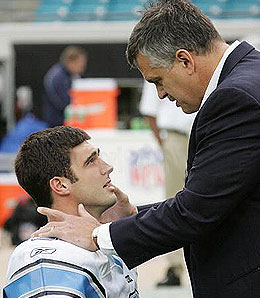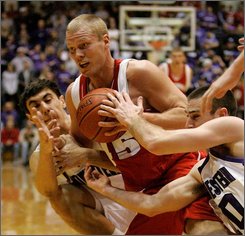
After Iowa State lost within the opening hours of the first round (sic) of the NCAA Tournament, I didn’t even bother checking my bracket (IlliNIT Blues) until yesterday since I had figured my horrible Final Four prognostication skills (having had first weekend losers Iowa State and Villanova in addition to Kentucky and Wisconsin) would leave me in smoldering ashes. So, I was quite surprised to see that I’m second place in my work pool and nearly in the top 5% of the ESPN brackets nationwide. Granted, my entry is guaranteed to have a Harrison Ford-piloted crash like the 1969 Cubs (or 1984 Cubs or 2003 Cubs or 2008 Cubs) since my points possible remaining are extremely low (as in Illinois basketball scoring in crunch time low), but it goes to show you how there’s still life even when half of your Final Four is gone within a 72 hour period.
As noted in last week’s post, the conference realignment front is fairly quiet these days for the power leagues with the exception of the prospect of Arizona State joining Big Ten hockey. However, there are some rumblings in the non-FBS Division I conferences that are basketball-focused, so let’s get the lay of the land:
(1) Big East Expansion (or lack thereof) – The Big East has the ability to poach any non-FBS Division I school that it wants (which is something that not even the Big Ten or SEC can say at the FBS level). Every school from the Atlantic 10, West Coast Conference, Missouri Valley Conference and any other non-FBS league would take a Big East invite immediately. From there, any Big East expansion would have a massive trickle-down effect on the conferences below them. However, the Big East is sort of in the same position as the Big 12: it really does want to expand (regardless of what their respective commissioners and other PR people might say publicly), but the issue is that there aren’t 2 glaringly obvious candidates. As I’ve stated previously, St. Louis University seems to be the main lock for a future Big East invite regardless of how they might be performing on-the-court at any given time. SLU has the TV market, academic institutional fit as a private Catholic university, geographic location as a bridge between Creighton and the rest of the league, and facilities that the Big East is looking for as a total package. So, the primary issue is finding a partner for SLU, which isn’t as clear. Dayton has played very well on-the-court with a great fan base along with being a private Catholic school, but its TV market isn’t as attractive, Xavier is close in proximity, and there’s going to be consternation within the league about adding two Midwestern schools (as opposed to finding at least one Eastern expansion candidate). VCU has also been great on-the-court and has a desirable location, but it’s a large public school that isn’t an institutional fit with the rest of the Big East. Wichita State (which we’ll examine even further in just a moment) has the same institutional fit problems as VCU with a much less desirable location and TV market. Richmond is a great academic school with a solid basketball program, but it competes in the same market as VCU with fewer fans and a lower national profile. Davidson is similar to Richmond and has the advantage of the Charlotte market, but has a very small enrollment and alumni base (albeit wealthy and academically elite).
If I were a betting person, SLU and Dayton are still the odds-on favorites to eventually get into the Big East once it decides to expand. I feel that the fact that VCU is a public school ultimately tanks their candidacy even though they are attractive on virtually all other factors that the Big East desires in terms of location, TV market, fan base and location. Wichita State has never been a realistic Big East candidate since their issues are much broader beyond being just a public university (as you’ll see below). Richmond might be able to wedge into the mix if they can get some more high profile NCAA Tournament runs – as of now, their on-the-court attributes are going to matter more than their off-the-court attributes (which already fit well with the Big East).
For now, the biggest emerging challenger to Dayton for spot #12 in the Big East is Davidson. The small number of students at Davidson isn’t optimal, but the Big East has always been more of a TV league dependent upon casual large market fans as opposed to an alumni-based league (unlike the Big Ten and SEC). Davidson is within the Charlotte TV market, has legitimately elite level academics, performs well on-the-court, and would address the wariness of Georgetown, Villanova and St. John’s of adding two Midwestern schools. So, keep an eye out on Davidson on the Big East expansion front.
(2) Wichita State: Nowhere to Run – The non-FBS school that I get asked about the most lately regarding switching conferences is Wichita State (and that has accelerated this past week with their current Sweet Sixteen run). I certainly understand the fan love – as you can see from my bracket, I have the Shockers going to the Elite Eight (and as far off as I was on Iowa State, I was equally convinced that Wichita State would come out blazing against Kansas). However, as much as Wichita State was wrongly underrated by the NCAA Tournament Selection Committee this year, the school is overrated by most sports fans as a conference realignment candidate. When I started writing about conference realignment with the Big Ten expansion index, my credo was always: “Think like a university president, not like a sports fan.” Wichita State is a perfect example of the disconnect between the thought processes of sports fans and university presidents. Sports fans see Wichita State as a school with great fans and astounding on-the-court success with a recent Final Four appearance and a memorable takedown of Kansas to get to the Sweet Sixteen this year. However, university presidents see Wichita State as a non-flagship public school that’s ranked in the 200s in the U.S. News rankings that’s located in a small TV market with little recruiting value (whether for athletes or “regular” college students). Remember that university presidents care just as much about what a school brings to the table when it’s awful on-the-field/court compared to how well it’s performing at its peak. Wichita State is a classic case of looking great for fans when they’re playing well, but it’s extremely tough for university presidents to see their value when they’re not playing well (as they’re not bringing academic prestige, an institutional fit, a major TV market, etc.).
Just look at the conferences that would be a step up from the MVC for Wichita State. The Big East, as noted above, is one of the most institutionally-aligned conferences outside of the Big Ten and Ivy League, where all members are private urban schools with a basketball focus. As a result, Wichita State simply isn’t a viable Big East candidate. The Atlantic-10 has some public universities, but it’s still more similar to the Big East as being private school-centric and the league may very well retrench from the Midwest if/when the Big East takes SLU. The American Athletic Conference (AAC) and Mountain West Conference (MWC) don’t seem interested at all in adding non-football members, so Wichita State won’t be considered. Even the West Coast Conference (which is a geographic stretch for Wichita State) has the same type of private school lineup as the Big East.
Unfortunately for Wichita State, it doesn’t matter how well the Shockers might perform on-the-court. Much like the power conference invite prospects for UConn (who has been an elite men’s and women’s basketball power), the off-the-court issues prevail in conference realignment and, as the old adage goes, “It takes two to tango.” Wichita State can want to leave the MVC all that it wants, but the conferences hold the power here. It’s not Wichita State’s choice to make to leave, so its only realistic option is to strengthen the MVC.
(3) MVC Expansion and UAB (and the Chain Reaction for the Horizon League and Others) – Fortunately for Wichita State, the debacle of UAB getting its football program stripped by the University of Alabama power brokers in Tuscaloosa (with new allegations that it was a predetermined decision that was railroaded through the UAB leadership) might end up having a solid UAB basketball program that just scored a huge upset of my Final Four pick Iowa State fall right into the laps of the MVC. Conference USA appears to want to have all members to have football, so the league may kick out UAB for having had the misfortune of being governed by self-interested political appointees from a more powerful campus. As a result, UAB’s future conference membership for basketball and other sports is in flux, with Al.com reporting that there is mutual interest between UAB and the MVC. As horrible as the UAB football situation has been, the MVC would be about as good of a landing spot for the UAB basketball program as it could reasonably expect and, in turn, UAB is about as good of an expansion candidate that the MVC could realistically invite.
If the MVC adds UAB, the league would be unlikely to stay at just 11 members. This means that it will have to find a 12th school somewhere, which could then cause a chain reaction throughout many of the non-FBS conferences below them. When the MVC was exploring expansion a couple of years ago and ultimately decided upon inviting Loyola, the league had explored UIC and Valparaiso of the Horizon League heavily. This makes sense from a university president perspective – all 3 of Loyola, UIC and Valpo are located in the Chicago market, which is where a disproportionate number of MVC students and alums live. (A notable exception to this is Wichita State, which doesn’t have much of an alumni presence in the Chicago area.) The basketball fans within the MVC would probably prefer a pure on-the-court-focused addition like Murray State (although Valpo does have some on-the-court bona fides), but I’d expect MVC school #12 to be another Chicago market school. The demographics of the MVC generally look like the old Big 8, which isn’t sustainable for a league for the long-term. The irony is that Wichita State, the most important school in the MVC, would likely be unhappy about another Chicago area school, yet the rest of the MVC membership knows that Wichita State can’t go anywhere else for the reasons set forth above (which means that the most valuable school in the conference might have the least say in expansion matters).
This prospect of MVC expansion might be why the Horizon League commissioner has already said that it’s in the “active phase” of expansion and the league would likely expand in the near future. The Horizon League has already been interested in schools like Northern Kentucky (currently in the Atlantic Sun) and Belmont (an Ohio Valley Conference member) and the conference may need to also backfill in the event that it gets raided by the MVC (which could put Summit League schools such as Nebraska-Omaha into play).
As you can see, even one move by a smaller conference like the MVC could end up triggering large repercussions throughout Division I conferences. If the Big East were to expand, it could cause mass-scale change for non-FBS conferences on the level that we saw in 2010-2013. Of course, if the Big 12 were to expand, then all bets are truly off throughout college sports.
(Image from Fox Sports)






